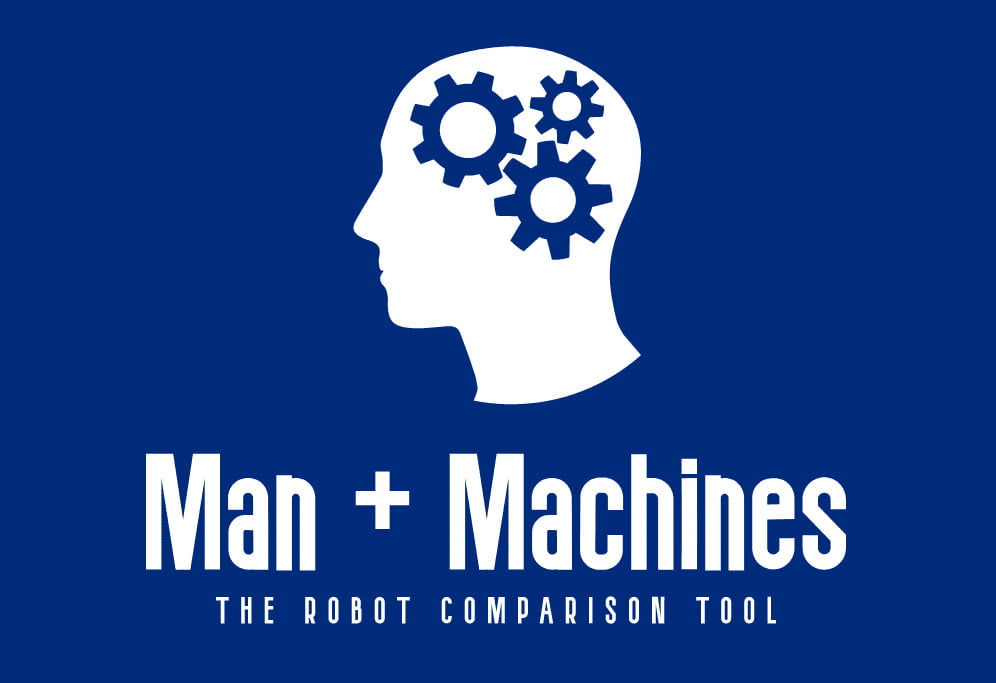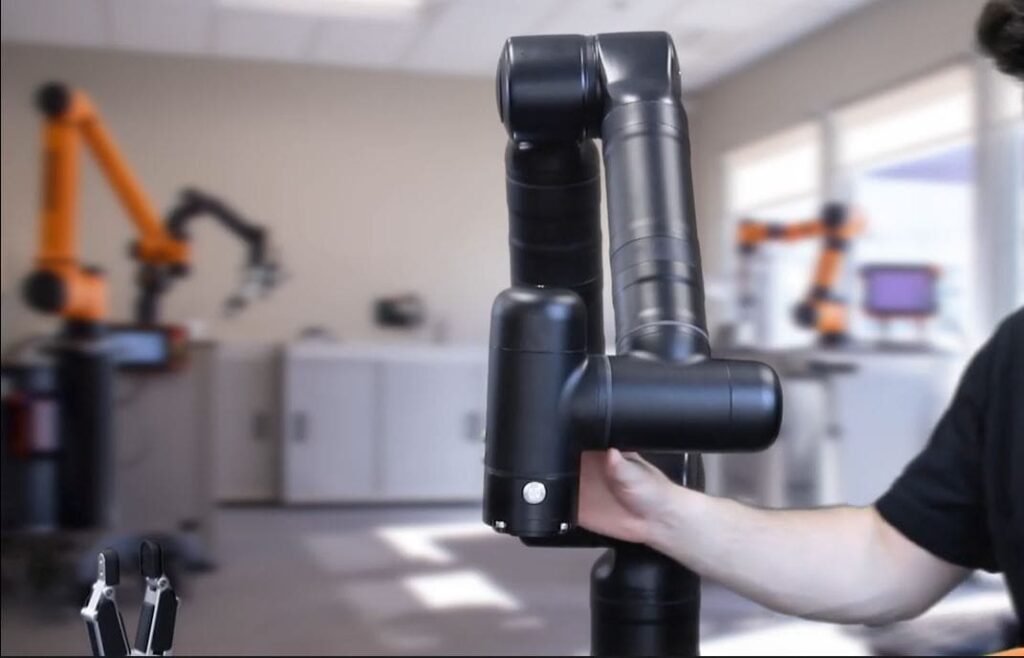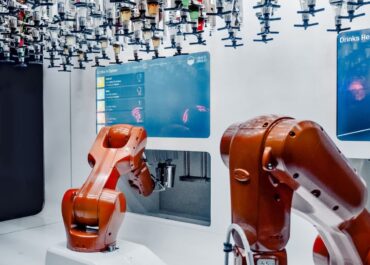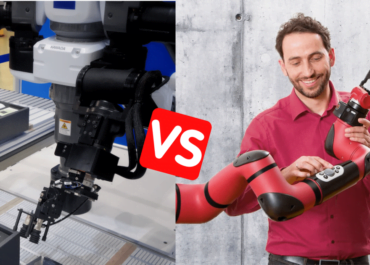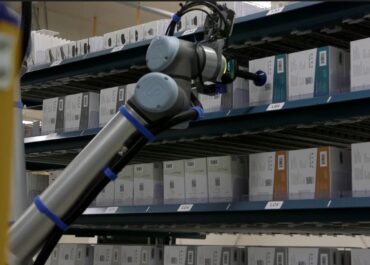Collaborative robots (or cobots) have caught your attention, and you want to know more about them?
We can relate, as these beautifully-designed robots can also bring significant improvements to your factory’s work organization.
Here’s how these robots work and how you can use them on your production lines.
Collaborative Robots : a quick definition
Let’s start with the basics.
A collaborative robot (or cobot) is a new type of robot that can safely work alongside industrial operators on the shop floor.
With enhanced sensing capabilities and lightweight design, collaborative robot arms prevent harmful collisions and can be guided by human hands.
Compared to standard industrial robots, they are also more affordable, easy to use, and quick to deploy to new applications or work settings.
Who Invented Cobot ?

Collaborative robots are the result of a long history of research and industrial engineering. To keep it simple, they came from the original work of Michael Peshkin and J. Edward Colgate, researchers from Northwestern University.
During the 90s, they advised General Motor’s manufacturing plants as they were reporting worrying working conditions on their assembly lines. Even with automated conveyors, operators still had to lift heavy loads all day long.
Peshkin and Colgate designed an intelligent winch system that lifted loads by detecting movement intents. Workers had to put minimal muscular effort into carrying any object.
They then patented their device as “co-bot” or collaborative robots, as they can work in physical interaction with human workers thanks to their sensing capabilities.
Another addition to cobot history is the work of the German Aerospace Center Institute’s engineers during the 90s. They were the first to add a torque and force sensor to a robot.
To train astronauts, they wanted a lightweight and flexible design that could respond to astronauts’ movements. The torque, joint, and force sensors enabled real-time responses and easy hand-guided control. It gave birth to Kuka’s first commercially available robot in 2004.
Soon, other companies like Universal Robot and Rethink Robotics launched their robot models to fit the specific needs of SME industries.
What are the benefits of cobot for industrial companies?
Cobots’ game-changing features and specs make automation more accessible than ever to factories. They bring seducing benefits to manufacturers:
- Affordability and quick ROI: less than 50k dollars for an initial investment and significant productivity gains.
- Flexibility and quick implementation: with a user-friendly coding interface and lightweight design, they easily adapt to part or production line variations, especially on high-mix low-volume processes.
- Accurate and ever-evolving sensing technology: cobots connect to a wide and growing network of advanced technologies like vision computing, gripping or material tools.
- Safety and Human-centered design: their lightweight and appealing design enable close physical interactions, while also making them more accepted among workers.
What do Cobots do?

Due to their lower specifications, some think that collaborative robots have fewer capabilities than industrial robots. But that’s simply not true.
Their versatile robot arm and compatibility with a wide range of tools make them excel in many applications. It all depends on your range of specifications:
Low reach and payload :
- Pick & place: they can pick a part, move it, and put it in a bin. They can even sort parts by colors and shapes thanks to vision computing features.
- Assembly: they can put together parts following a specific plan they are trained on.
- Quality inspection: they can inspect and monitor part quality thanks to force or vision sensors.
- Teaching: they can be used to introduce students to robotic programming.
Medium reach and payload
- Welding: they can hold a welding torch and fuse parts properly.
- Finishing: they can accurately sand and polish parts.
- Dispensing: they can evenly pour gluing and sealing liquids on your work material.
- Screwing: they can screw your parts from any angle.
High reach and payload :
- Machine-tending: they can load heavy parts on CNC, molding, or milling machines and then unload them.
- Packing and palletizing: they can hold, move and store heavy parts and boxes with consistent motion.
Where can cobots be used?

As you can see, you can use collaborative robots in many ways. Thanks to their space-saving and adaptable specifications, they can also work in many different settings and factory environments.
Here’s a list from the most common to the least common industries where cobots are used :
- Electronics
- Logistics
- Furniture
- Automotive
- Metalwork
- Research & Pharmaceutical
- Food
- Agriculture
What are some examples of cobot models?
Since the beginning of this century, robotic suppliers have been putting various cobot models on the market. Here are the most popular models that you can find on the market :
UR series

With its UR models, Universal Robot is the true leader of the cobot market. With versatile capabilities, an easy-to-use interface, and a wide network of end-effectors, the UR models provide the best value for money for automation starters. They also have a range of specifications that can fit any of your applications.
Doosan M, A and H series

Doosan cobots are no doubt the most technically impressive models on the market. From 5 to 25 kg payload and 900 mm to 1700 mm reach, their technical specs enable them to do almost everything. And as if that wasn’t enough, they are also easy to use, very safe, and esthetically pleasing.
TM Series

TM cobot models stand out for their sensing and vision capabilities, as well as their wide specs range. Their built-in vision intelligent system enables them to do high-accuracy and error-proof work.
Fanuc CRX Series

Fanuc CRX Series delivers all the features to get started in automation. With one of the most intuitive user-interface, anyone can program them and get them running. They also benefit from long-standing Fanuc’s quality build and partner ecosystem.
Are Cobot Really Safe?

Cobots provide fine-tuned safety features to prevent collisions and hazards. In that sense, they all comply with ISO 10218, the safety standards for industrial robots.
However, that doesn’t mean the way you implement and use them is inherently safe. You still need to do a risk assessment to properly integrate the robot into your working cell. You have to consider the potential hazards coming from your tools attached, the work material, and the interaction with your human operator.
What are the different types of collaborative robots?
According to ISO 10218, there are four types of collaborative robots, depending on the safety features they use. Even though models often provide safe-rated features from different categories, it’s a good start to sort out cobots :
Safe stop
Those cobots provide features that stop the robot’s motion in case of perceived danger. That could involve emergency stop features on the teaching pendant or other high-end collision sensing technologies. Universal Robots and Dobot models are good examples of that.
Power and Force Limiting cobots
Those collaborative robots rely on their force and torque sensing capabilities to detect unwanted physical interactions. They automatically figure out the difference between the force produced and required to perceive danger, and instantly brake or slow down. ABB and Franka Emika models work like that.
Speed and Separation cobots
Cobots can also have space-delimitation features. Users can define different work areas based on operator safety. The robot can then adapt its speed and power depending on the area it’s working in, while operators can safely walk in other areas. Doosan models provide this type of feature.
Hand Guiding cobots
The vast majority of cobots enable hand-guiding control. That means operators can use their hands to hold and move the robot arm without any harm. As they rely on their own force, they can safely teach the robot its working path.
What are the tools of cobots ?

To handle new applications, cobot arms need to connect to various tools and end-effectors. Here are the types of tools that you can add to your robotic arm :
- Grippers
- Force/torque sensor
- Tool changer
- Screwer
- Orbital sander
- Welding torch
- Material dispenser
- …
Have we addressed all of your questions? If so, then it’s time to try cobots by yourself!
